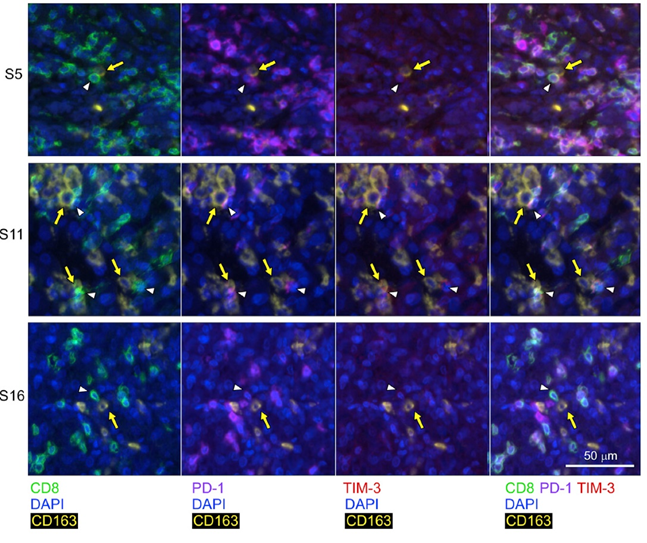
1/ Happy to share our latest work out today in @Cancer_Cell – a single-cell dissection of the kidney cancer immune microenvironment that uncovers important immune circuitry in advanced disease stages @DanaFarber @DanaFarberNews @harvardmed @broadinstitute
cell.com/cancer-cell/fu…
cell.com/cancer-cell/fu…
2/ The immune microenvironment plays critical roles in controlling the progression of cancer and in response to immunotherapies, yet there are still key open questions regarding the immune cell composition, phenotypic states, and cellular interactions in kidney cancer
3/ To comprehensively dissect the immune microenvironment in kidney cancer, we performed scRNA-seq / scTCR-seq) on 164,722 individual cells from tumor and adjacent non-tumor tissue in patients with ccRCC across disease stages: early, locally advanced, and advanced/metastatic 



4/ We uncovered transcriptionally heterogeneous infiltrating T cell populations, but they separated into two main groups – exhausted CD8+ T cells and non-exhausted T cells. In advanced disease stages, there was a substantially higher proportion of exhausted CD8+ T cells 



5/ Further, trajectory inference analysis of CD8+ T cells produced a mostly linear trajectory. We again saw an interesting pattern – CD8+ T cells from normal tissue and early stage ccRCC were early in pseudotime, and CD8+ T cells from more advanced disease were late in pseudotime 

6/ So what biological program was driving this trajectory? When we examined individual genes and gene programs, it became clear it was T cell exhaustion 



7/ Next, through single-cell paired alpha-beta TCR sequencing of over 60,000 infiltrating T cells, we described the TCR repertoire and clonotype-phenotype relationships 



8/ Surprisingly, we found incredibly clonotype enrichment in some tumors. In one case, almost 50% of infiltrating T cells were all recognizing one target antigen. This is motivating our future work to uncover the relevant tumor antigens in RCC 

9/ Linking clonotype to phenotype, we found that exhausted CD8+ T cells (enriched in advanced disease stages) also had a more restricted TCR diversity 



10/ We then turned our attention to the myeloid compartment. Here too, we found that M2-like tumor-associated macrophages (TAMs) were enriched in more advanced disease stages 

11/ Macrophages can exist on a spectrum rather than in discrete states, so we again used trajectory analysis. An interesting pattern emerged – classical monocytes branched into non-classical monocytes or into macrophages. There were clear differences between disease stages 

12/ When we looked at the macrophage branch, those from advanced tumors were late in pseudotime, had an anti-inflammatory phenotype and expression of “M2-like” markers 



13/ Exhausted CD8+ T cells and M2-like macrophages were both enriched in advanced disease stages, but did these cells talk to each other? We used #CellPhoneDB to infer cell-cell interactions, and inferred that these two populations did in fact communicate 

14/ What were these interactions? The TAMs made ligands for T cell inhibitory receptors (supporting T cell exhaustion), and the exhausted CD8+ T cells made factors that support M2-like polarization of TAMs 

15/ These exhausted CD8+ T cells and M2-like macrophages seemingly formed a bi-directional “immune dysfunction circuit” in more advanced disease stages 

16/ We confirmed protein-level expression of these ligands and receptors using high-dimensional flow cytometry, and confirmed co-localization of these two immune populations in advanced disease using multiplex immunofluorescence 

17/ We confirmed our findings in other publicly available datasets, in part using a gene signature for exhausted T cells – TAM interactions. In multiple external cohorts, high expression of this interaction signature was associated with a worse prognosis, even within stage IV RCC 



18/ Overall, these results support a model of progressive immune dysfunction with advancing disease stage, with exhausted T cells and M2-like macrophages forming an “immune dysfunction circuit” in later disease stages 

19/ What’s next? We hope to examine if these interactions can be inhibited to restore immune function and, ultimately, see if they can be therapeutically targeted to help our patients with ccRCC
20/ This was an enormous TEAM EFFORT. I first want to thank the patients and families who made this work possible. Huge thanks to my co-lead on this work @justokstreet. And just an enormous thanks to my mentors #CathyWu and @DrChoueiri, who made this possible
21/ Thank you to our many other close collaborators (@rafalab, @LabSignoretti, #ArleneSharpe, +many more), our funders (incl @CDMRP, DF/HCC Kidney Cancer SPORE / @theNCI).
cc @KidneyCancer @kidneycan @IKCCorg @ScienceinBoston @dfcidatascience
cc @KidneyCancer @kidneycan @IKCCorg @ScienceinBoston @dfcidatascience
22/ Please also check out the outstanding work in @Cancer_Cell from @VanAllenLab #KevinBi @MXresearch @DrChoueiri about immune (and tumor) cell “reprogramming” that takes place during immunotherapy in advanced RCC:
cell.com/cancer-cell/fu…
cell.com/cancer-cell/fu…
• • •
Missing some Tweet in this thread? You can try to
force a refresh


